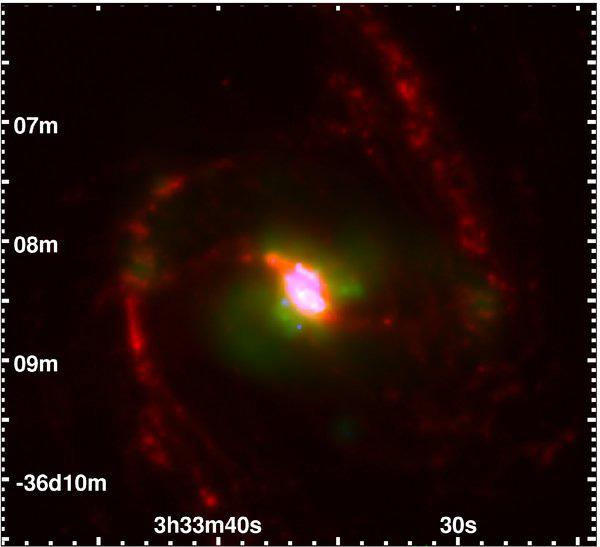
A false color composite image of the Seyfert galaxy NGC 1365. Red is infrared seen by the Spitzer Space Telescope; green and blue are two X-ray colors as seen by the Chandra X-ray Observatory. Using Chandra, astronomers found that there is probably a ring of very active star formation surrounding the black hole in this galaxy. (The numbers on the edges are spatial coordinates).
Seyfert galaxies are similar to normal galaxies like our own Milky Way except in one critical respect: their nuclei are fantastically bright -- in extreme instances as luminous as 100 billion suns. Astronomers think that these huge energies are generated in Seyfert nuclei by massive black holes. Matter, as it falls in towards the vicinity of a black hole, heats up due to friction and radiates intensely. The Milky Way also has a massive black hole at its center, and there is evidence that some matter is falling in towards it, but for reasons that are not understood the center of our galaxy is not particularly bright as compared to its star-filled spiral arms. By way of contrast, quasars are galaxies whose nuclei glow intensely but whose stars are very faint, almost undetectable. Astronomers suspect that Seyferts may be an intermediate stage between these two extremes, and wonder whether some types of normal galaxies might pass through a Seyfert phase of life, or even end up one day as quasars. They are also trying to understand how activity around a black hole might influence other parts of the galaxy.
CfA astronomers Junfeng Wang, Pepi Fabbiano, Martin Elvis, and Guido Risaliti, along with three colleagues, used the Chandra X-ray Observatory to study the circumnuclear region around the black hole of the Seyfert galaxy known as NGC 1365 located about 60 million light-years away. In addition to stars forming in its bright spiral arms, this galaxy has a circumnuclear region that hosts star formation processes so intense that they outshines the cumulative emission of many other galaxies in their entirety. The galaxy also has a biconical outflow of material, perhaps driven by energy either released in the circumnuclear starburst or by matter infalling to the black hole.
The astronomers show from their analysis that nuclear emission from infall towards the black hole cannot account for the X-rays in the
biconical outflow they see, but supernova explosions can readily produce both the radiation and the relative abundances of the elements observed. Supernovae are signs of active star formation because in the process of producing new stars, massive ones (which die as supernovae) form, evolve, and explode in a short time in the midst of the stellar nursery. The team's result supports the idea that the circumnuclear ring in this galaxy is actively making stars. It also offers an explanation for the hot wind: at least in this Seyfert galaxy the outflow is driven by these supernovae, and not by nuclear activity.